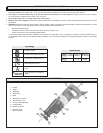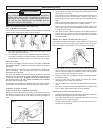
page 7
General Cutting
For straight or contour cutting from an edge, line the blade up with your
cutting line. Before the blade contacts the workpiece, grasp the handle
firmly and pull the trigger. Then guide the tool along your cutting line.
Always hold the shoe flat against the workpiece to avoid excessive
vibration.
Cutting Metals
Begin cutting at a slow speed, gradually increasing speed as you cut.
When cutting into metals or hard materials that can not be cut from an
edge, drill a starting hole larger than the widest part of the blade. Extend
blade life by using a solid blade cutting lubricant such as MILWAUKEE
Band Saw Blade Lubricant Cat. No. 49-08-4206.
Plunge Cutting (Fig. 6)
Your MILWAUKEE Sawzall
®
is ideal for plunge cutting directly into sur-
faces that can not be cut from an edge, such as walls or floors. Plunge
cutting may be done two ways depending on how the blade is inserted.
Column A shows how to plunge cut with the teeth of the blade facing
down. Column B shows how to plunge cut with the teeth of the blade
facing up. Do not plunge cut into metal surfaces (see Cutting Metals).
1. Insert the blade into the tool.
If you inserted the blade with the teeth facing downward, hold the
tool as shown in Column A, resting the edge of the shoe on the
workpiece.
If you inserted the blade with the teeth facing upward, hold the tool
as shown in Column B, resting the edge of the shoe on the workpiece
as shown.
2. With the blade just above the workpiece, pull the trigger. Using the
edge of the shoe as a pivot, lower the blade into the workpiece as
shown.
3. As the blade starts cutting, raise the handle of the tool slowly until
the shoe rests firmly on the workpiece. Then guide the tool along
your cutting line to acquire the desired cut.
NOTE: To make plunge cutting easier, use a heavy gauge blade and
install the blade with the teeth facing upward as shown in Column B.
Fig. 6
WARNING!
To reduce the risk of explosion, electric shock and property
damage, always check the work area for hidden gas pipes,
electrical wires or water pipes when making blind or plunge
cuts.
Maintaining Tools
Keep your tool in good repair by adopting a regular maintenance pro-
gram. Before use, examine the general condition of your tool. Inspect
guards, switches, tool cord set and extension cord for damage. Check
for loose screws, misalignment, binding of moving parts, improper mount-
ing, broken parts and any other condition that may affect its safe opera-
tion. If abnormal noise or vibration occurs, turn the tool off immediately
and have the problem corrected before further use. Do not use a dam-
aged tool. Tag damaged tools DO NOT USE until repaired
(see Repairs).
Under normal conditions, relubrication is not necessary until the motor
brushes need to be replaced. After six months to one year, depending on
use, return your tool to the nearest MILWAUKEE service facility for the
following:
Lubrication
Brush inspection and replacement
Mechanical inspection and cleaning (gears, spindles, bearings,
housing, etc.)
Electrical inspection (switch, cord, armature, etc.)
Testing to assure proper mechanical and electrical operation
MAINTENANCE
Cleaning
Clean dust and debris from vents. Keep the tool handles clean, dry and
free of oil or grease. Use only mild soap and a damp cloth to clean your
tool since certain cleaning agents and solvents are harmful to plastics
and other insulated parts. Some of these include: gasoline, turpentine,
lacquer thinner, paint thinner, chlorinated cleaning solvents, ammonia
and household detergents containing ammonia. Never use flammable or
combustible solvents around tools.
Repairs
If your tool is damaged, return the entire tool to the nearest service
center.
WARNING!
To reduce the risk of injury, always unplug your tool before
performing any maintenance. Never disassemble the tool or
try to do any rewiring on the tool's electrical system. Contact
a MILWAUKEE service facility for ALL repairs.
WARNING!
To reduce the risk of injury, electric shock and damage to the
tool, never immerse your tool in liquid or allow a liquid to flow
inside the tool.


















